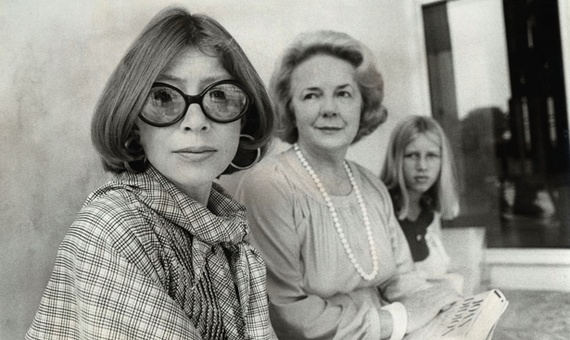The author and champion of “new journalism” turned 80 years old today.
by Kaylen Ralph
Our love for Joan Didion isn’t a secret. You might even say the lasting power of her literary journalism was an inspiration in starting this publication. In honor of the OG’s birthday, we’ve compiled eight of our favorite Didion pieces, one for each decade of her life. Have a favorite that we missed? Let us know! Let’s spread the Didion love.
1. “Some Dreamers of the Golden Dream”
Slouching Toward Bethlehem, 1968 (originally published under the title, “How Can I Tell Them There’s Nothing Left” in the Saturday Evening Post, 1966)
This is a portrait both of a person and a place. Didion recounts the story of Lucille Miller in all its dirty detail—a marriage that goes up in literal flames and the sordid affair that implicates her as responsible for her husband’s death. Didion gives us the details, but in such a way that we can only imagine them occuring in “a place like San Bernardino, a place where little is bright or graceful, where it is routine to misplace the future and easy to start looking for it in bed.”
Slouching Toward Bethlehem, 1968 (originally published under the title, “Farewell to the Enchanted City” in the Saturday Evening Post, 1967)
The essay that is now the namesake of an entire anthology dedicated to the idea of leaving New York as a writer. Ever the trendsetter, Didion did it first.
The White Album, 1979 (originally published in New West, 1979)
With it’s killer opening, “We tell ourselves stories in order to live,” Didion transcends the “autobiographical essay” genre, though that’s how this work is categorized. Using her own life experiences as inspiration, Didion recounts experiences covering the Black Panthers, the Doors and Charles Manson’s reach.
The White Album, 1979 (originally published on July 30, 1972 in The New York Times)
From a critical standpoint, Didion analyzes the evolution of the women’s movement, how each wave is different from the next.
“More and more, as the literature of the movement began to reflect the thinking of women who did not really understand the movement’s ideological base, one had the sense of this stall, this delusion, the sense that the drilling of the theorists had struck only some psychic hardpan dense with superstitions and little sophistries, wish-fulfillment, self-loathing and bitter fancies.”
5. Salvador
1983
Hauntingly prescient today, this is a story of American involvement in El Salvador in the early 1980s. Didion shows her range in this book-length essay of political reporting, the kind with which we could certainly do with more of now.
6. The Year of Magical Thinking
2007
An intimate self-portrait of grief, The Year of Magical Thinking starts with the death of Didion’s husband, John Dunne, in 2004, and “ends” a year later, when “the craziness is receding but no clarity is taking its place.” More than an exploration of terror, confusion, and self-pity, it is a stunning window into a marriage in which two writers find nearly forty years of love, sustenance, and creative energy.
7. Blue Nights
2012
After The Year of Magical Thinking on grief and family, Blue Nights and its subject matter—Didion’s daughter dies in 2005 after a seemingly harmless bout with pneumonia—seems too bad to be true. After losing her husband, she has now lost her only child. In her reflective state, she is able to broaden the prose beyond her own personal scope. She speaks expertly and frankly on grief, family and letting go.
8. We Tell Ourselves Stories in Order to Live, the Joan Didion Documentary
We’re really looking forward to this documentary from director Griffin Dunne (he’s known Didion his entire life) in partnership with co-director Susanne Rostock. Plenty has been produced about Didion’s life, but never in documentary form. It will feature Didion reading aloud from self-selected passages of her own work, as well as the perspectives of some of her close friends (Patti Smith, Graydon Carter, etc.)
(Photo credit: Teresa Zabala/The New York Times/Redux/The Atlantic)
[hr style=”striped”]
Kaylen is one of The Riveter’s co-founders and the EIC. She moved to Minneapolis, MN after graduating from the Missouri School of Journalism in August 2013. In addition to her editorial duties at The Riveter, Kaylen also works as a freelance researcher for The Sager Group. You can follow her on Instagram and Twitter at @kaylenralph.




